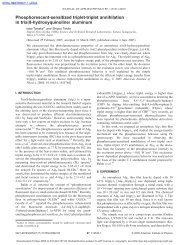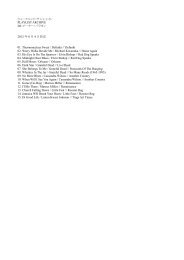Children's Television: Trends Around the World
Children's Television: Trends Around the World
Children's Television: Trends Around the World
Create successful ePaper yourself
Turn your PDF publications into a flip-book with our unique Google optimized e-Paper software.
CHILDREN’S TELEVISION: TRENDS AROUND THE WORLD<br />
THE EFFECTS OF INCREASED CHILDREN’S PROGRAMMING<br />
105<br />
A quarter of a century has passed since <strong>the</strong> arrival of <strong>the</strong> first children’s television<br />
channel, America’s Nickelodeon, which was launched in April 1979 as<br />
part of <strong>the</strong> basic cable television service in <strong>the</strong> United States. With its motto of<br />
“Kids first,” Nickelodeon aimed to broadcast a variety of age-specific children’s<br />
programs. Its introduction was motivated by dissatisfaction with <strong>the</strong> current<br />
state of American children’s programming: public television was constrained<br />
by financial uncertainty, and <strong>the</strong> three commercial networks offered a diet of little<br />
more than conventional cartoons interspersed with advertising. Nickelodeon<br />
soon grew to become <strong>the</strong> American channel child viewers watched most, and its<br />
programs are now shown in 162 countries and regions around <strong>the</strong> world.<br />
The Spread of Children’s Channels<br />
Following on <strong>the</strong> heels of Nickelodeon’s success, o<strong>the</strong>r children’s channels<br />
and cartoon channels were launched in North America and Europe in <strong>the</strong><br />
1980s. By <strong>the</strong> end of <strong>the</strong> 1990s, such channels had spread all over <strong>the</strong> world<br />
to Asia, Oceania, Latin America, <strong>the</strong> Middle East and Africa. 2 Among <strong>the</strong>se<br />
children’s channels, two clear categories have emerged. The first comprises<br />
U.S.-produced children’s channels, such as Nickelodeon, Cartoon Network,<br />
and Disney Channel, which give limited airtime to local programs but tend to<br />
be dominated by American programs. The second category includes channels<br />
launched by o<strong>the</strong>r countries, predominantly during <strong>the</strong> 1980s, such as <strong>the</strong><br />
United Kingdom’s Children’s Channel, France’s Canal J, Canada’s YTV and<br />
<strong>the</strong> Ne<strong>the</strong>rlands’ KinderNet. 3<br />
An international survey conducted in 1993 by NHK Broadcasting Culture<br />
Research Institute revealed that points of concern for many television producers<br />
and broadcasters included <strong>the</strong> lack of children’s programs and <strong>the</strong> weak<br />
position of children’s programming within broadcasting corporations. 4 In this<br />
context, <strong>the</strong> advent of children-specific channels offered significant new<br />
opportunities for <strong>the</strong> supply of children’s programs. What happened in reality,<br />
however, was that <strong>the</strong>y acted to increase <strong>the</strong> number of American-style programs,<br />
predominantly cartoons, being shown, leading to misgivings about <strong>the</strong><br />
lack of variety in programming and <strong>the</strong> “cultural invasion” resulting from<br />
imported programs.<br />
2 Kodaira Sachiko, “Amerika ni miru dejitaru jidai no kodomo-muke sabisu” [Digital TV<br />
Services for Children in <strong>the</strong> United States: Debates on <strong>the</strong> Launch of <strong>the</strong> PBS Kids Channel],<br />
HKC (September 1999), pp. 2–27.<br />
3 Kodaira Sachiko, “Kodomo-muke sabisu no tenbo: Obei media no saishin doko kara” [Future<br />
Prospects of Media Services for Children: From Recent <strong>Trends</strong> in Europe and America].<br />
HKC (January 2001), pp. 56–87.<br />
4 Kodaira Sachiko, “Kaigai no terebi kodomo bangumi saishin doko” [The Latest <strong>Trends</strong> of<br />
Overseas TV Programs for Children], HKC (October 1994), pp. 44–53.







